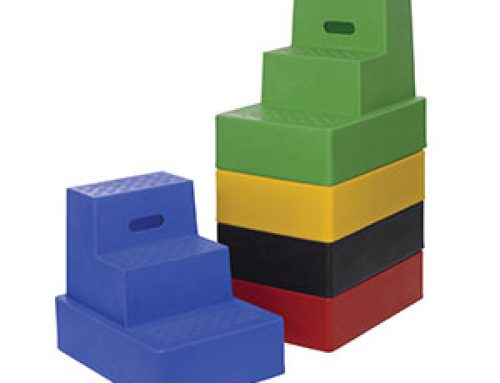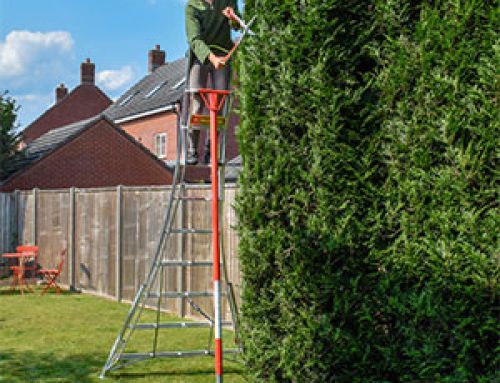Trying to work at height in the garden involves a lot of planning ahead. There are several jobs that need to be done at height including pruning hedges, trimming back overgrown trees and harvesting fruit. The safest way to get tall hedges trimmed or overgrown trees pruned back is to get a qualified tree surgeon who has all the necessary equipment. The equipment a tree surgeon has available includes ladders, scaffolding and harnesses that they can use to climb into a tree and work within the tree they are pruning, or into a neighbouring tree. Tree surgeons constantly learn new ways of climbing trees and how to work up trees, and if there’s a job in your garden which means working at a great height up a tree it’s best to get the trained professionals in. Working at height with gardening or arborist equipment is very dangerous and tree surgeons need years of experience and training to be qualified to use a chainsaw up a tree, in fact even before a tree surgeon is legally allowed to use a chainsaw up a tree they must be qualified in aerial rescue, meaning they can get themselves or others out of a tree with serious injury. Any type of work within a tree that involves using dangerous equipment should not be attempted by anyone other than a trained professional. However, for those smaller jobs there are a few interesting pieces of equipment available to make working at height easier and safer for you.
The traditional orchard ladder, also known as a tripod ladder, is a tapering ladder with a third leg for support, which extends from the top of the ladder down to the ground, forming a pyramid shape with the ladder rung rails. The actual ladder part of this contraption tapers inwards as it rises, so the feet are quite far apart. In conjunction with the tripod leg this creates a stable base designed especially for use on uneven and soft ground in a garden or orchard. Because the ladder gets smaller towards the top it can be set up very close to the centre of a tree and allows you to get right into the crown of the tree for thinning out, or for harvesting fruit. They are called orchard ladders because they were designed for picking apples, cherries, pears and other tree fruits and also for pruning the trees into the best shape for fruit bearing.
Orchard ladders are not meant to be used on firm, flat ground as the design of the flared legs means it fares better on the soft, undulating surface of an orchard or garden. When putting one of these ladders up the best thing to do is push the whole thing forwards towards the tripod leg to bed the ladder into the ground slightly, and also to make sure there are no animal tunnels underneath which the ladder could collapse into. The top two rungs of the ladder are not meant to be used as steps, but are there to stabilise the construction of the ladder and to provide something else to hold on to. Due to the tripod style design, these ladders are more stable than a normal step ladder when you’re working within a tree and turning or twisting around. The tripod construction makes the ladder more stable when the weight at the top is shifting around whereas with a normal step ladder, moving around too much at the top makes the ladder base unstable. The tripod design also means there is more flexibility as to where the ladder can be set up, as it needs less floor space than a four legged step ladder. This helps for getting into the middle of a tree, and also for getting close to hedges. The ladder can be set up with one side of the triangular footprint parallel to the hedge, making it easy to get close to the hedge itself.
There are also ladder systems designed specially for working on tall hedges. These follow a similar principle to the orchard ladder and have wide flaring legs creating a base that spreads the weight out over a large surface area, but instead of three legs these ladders have four (like a step ladder). They often have large footpads that help spread the weight and help to stop the ladder sinking on soft ground. A good example of such a ladder is the Hedgemate telescopic platform. This ladder is made with hedge trimming in mind but can also be used wherever a stable platform is needed, such as for gutter clearing and window cleaning. The front facing side of the ladder sits almost parallel to the hedge or wall, allowing the person at the top to get as close as possible to whatever they are working on. The platform at the top means that tools can be kept close by and reduces the leg fatigue you might get from standing on a ladder for too long; this system makes it more like standing on the ground while working at height! You can also use both hands to work, as there’s no need to hold on to the ladder with your arms. Additionally, the feet of this ladder platform system are all adjustable independently of each other, which means that it can be used on uneven terrain, different surfaces, and even on slopes.
The Hedgemaster ladders are quite similar to the Hedgemate platform except that the platform is smaller, and they look more like a step ladder. These ladders incorporate all the features you need for working outdoors including the adjustable feet and wide span of the legs, and also allow you to span flower beds, small walls and water features easily in order to reach the hedge or tree you’re working on. There are rails that help keep you in place while you’re working, and they come in several different heights, so there’s no hedge too large for this ladder. For working on hedges or trees which border a slope the legs can be set up so the ladder reaches across the slope, being supported by the different length legs. These sorts of ladders are easily moveable just by being picked up, but there are systems that can be wheeled along the length of a hedge, which is very useful for large gardens.
Work platforms such as the Gardeno system provide a large area to walk along, and also somewhere to keep harvested fruits and tools. The platform on this type of system is much bigger than on the hedge trimming models meaning it’s more adaptable to different types of work in the garden and also around the home. As it is on wheels it can be moved very easily, and without having to always bring all the tools or fruit down each time it is moved. However, the size and construction of work platforms such as this mean that they’re not always suitable for working on fruit trees, for either pruning or harvesting, as it’s more difficult to get into the middle of the tree with a system like this than with an orchard ladder. Depending on your needs and the other tools you might have available to you, the moveable platform could make light work of harvesting several trees without needing to unload fruit down a ladder every few minutes.
As you can see, there are different types of gardening ladder for different jobs, and it’s a matter of personal choice and need which will help you decide on the right one for you. If you’re stuck and need some advice in this area, give Midland Ladders a call on 01527 821 561 and we can talk you through the options.






Leave A Comment
You must be logged in to post a comment.